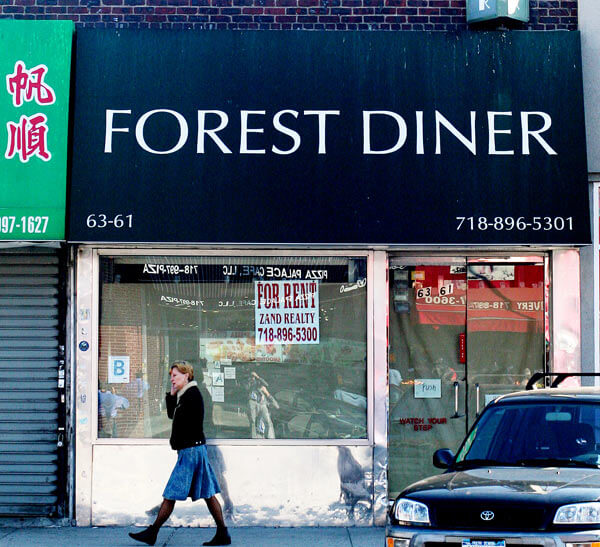By Joe Anuta
The Forest Diner on 108th Street in Forest Hills closed last month after slinging food for about 30 years, and some residents said its passing was a watershed moment in the history of the neighborhood.
Marian Silton pulled up in a car last week and was shocked to see the brown paper covering the windows and the “for rent” sign in the window.
“I can’t believe it!” she said, accentuating each word with a slap to her knee. “They were doing so well.”
The white-haired Silton did not specify how long, but said she had been coming to the diner for a number of years.
“Where are we going to go?” she asked a younger woman who was driving her.
Vasiadis Diamantis, who is listed in a 2005 city Department of Buildings document as the owner of the diner, could not be reached for comment.
Chai Frouz owns a store next to the diner near 63rd Drive and said the area is not the same as when the diner opened in the 1980s.
“There used to be a line to get in there on Sundays,” said Frouz, “But not anymore. The neighborhood changed.”
The numbers back up his story.
According to data from the 2000 and 2010 U.S. Census, the population in both Rego Park and Forest Hills declined from 44,189 to 43,600 and 70,204 to 68,733 people, respectively.
Citywide, the weak growth numbers reported by the census were disputed by Mayor Michael Bloomberg.
In Rego Park and Forest Hills, those population declines went hand-in-hand with housing vacancy rates that in some cases doubled over the 10-year period.
In 2000, the rental vacancy rate in Rego Park was 2 percent. In 2010, it was 3.8.
That number jumped from 2 percent to 4.4 percent in Forest Hills over the same period.
The two neighborhoods also became more diverse in the 10 years between each Census, with Asian and Hispanic populations increasing by several percentage points.
A representative from Zand Realty, which is trying to sell the vacant space, said the economy was to blame for the diner’s closing.
Economic data for the two neighborhoods could not obtained, but for the borough as a whole median household income fell from $55,117 to $53,054, a decline of nearly 4 percent.
That data is mirrored on a national level, where median household income also fell from $52,347 in 2010 to $50,046 in 2006.
But another factor may have contributed to the storied diner’s closing, according to Frouz. A small strip of 108th Street near 63rd Drive is home to four banks, and another one is on the way.
“The banks close at 3 p.m. and the block is dark,” he said.
According to a report from the city Department of Consumer Affairs, the area of Community Board 6 tied Flushing and Whitestone in Community Board 7 for the highest banks-per-household ratio in the borough.
Landlords in the area would rather rent to big-name banks or franchises to secure profits, Frouz said, rather than take a gamble on a small business like the diner.
“Why do we need so many banks?” he asked.
Reach reporter Joe Anuta by e-mail at januta@cnglocal.com or by phone at 718-260-4566.
































